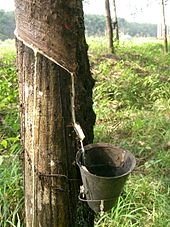Natural rubber, derived from the Hevea brasiliensis tree primarily found in tropical regions, plays a vital role in various industries, with the tire and rubber sector being a significant consumer. This material is indispensable due to its unique properties that are challenging to replicate synthetically. The European tire and rubber industry heavily relies on natural rubber, with the EU being entirely import-dependent for this commodity, mainly sourcing from countries like Indonesia, Thailand, Côte d’Ivoire, and Malaysia. The supply chain for natural rubber is intricate and involves smallholder farmers, raw material dealers, processing plants, traders, and manufacturers of rubber products.
The consumption of natural rubber globally is substantial, with China being the largest consumer followed by the EU, India, the US, Thailand, and Japan. Despite a contraction in global consumption in 2020 due to the pandemic’s impact on mature markets like the EU, US, and Japan, countries like China and Thailand experienced growth in consumption. The natural rubber supply chain is dynamic and fragmented, with latex harvested daily from trees and processed into raw natural rubber before reaching manufacturers.
Historically, natural rubber has a fascinating background. The earliest references to natural rubber date back to accounts of the New World’s discovery when American Indians were observed playing with balls made from tree juice. The first attempts at cultivating natural rubber began in 1876 when seeds were collected from Brazilian trees and sent to botanical gardens in England. Early uses of natural rubber included erasing pencil marks and waterproofing cloaks and shoes. The breakthrough came in 1839 with Charles Goodyear’s discovery of vulcanization using sulfur to create a durable form of rubber unaffected by temperature changes.
The production process of natural rubber involves tapping latex from Hevea brasiliensis trees through a method that collects the milky fluid in cups. This latex is then processed into various forms like ribbed smoked sheets or block rubber through coagulation, drying, and pressing into bales. Additionally, research has explored alternative sources like guayule and Russian dandelion to mitigate dependence on a single raw material source.
In conclusion, natural rubber’s significance spans industries worldwide due to its unique properties that are challenging to replicate artificially. Understanding its cultivation, historical significance, consumption patterns globally, supply chain intricacies, and processing methods sheds light on the critical role this material plays in modern society. Efforts towards sustainability and diversification of sources highlight the ongoing evolution of the natural rubber industry towards a more resilient and environmentally conscious future.
- https://en.wikipedia.org/wiki/Natural_rubber
Title: Natural rubber – Wikipedia
Summary: This page provides a comprehensive overview of natural rubber, including its history, production, properties, uses, and global market. It also covers the chemistry and processing of natural rubber, as well as its environmental impact and sustainability. - https://simple.wikipedia.org/wiki/Rubber
Title: Rubber – Simple English Wikipedia, the free encyclopedia
Summary: This page provides a simple explanation of rubber, including its definition, types, and uses. It also covers the history of rubber and its discovery by indigenous peoples in the Americas. - https://en.wikipedia.org/wiki/Rubber_elasticity
Title: Rubber elasticity – Wikipedia
Summary: This page provides an in-depth explanation of rubber elasticity, which is a property of crosslinked rubber that allows it to be stretched and then return to its original shape. It covers the molecular processes involved in rubber elasticity, as well as the history and economic importance of rubber. - https://en.wikipedia.org/wiki/Synthetic_rubber
Title: Synthetic rubber – Wikipedia
Summary: This page provides an overview of synthetic rubber, which is an artificial elastomer made from petroleum byproducts. It covers the history, types, and uses of synthetic rubber, as well as its advantages over natural rubber in terms of thermal stability and resistance to oils and chemicals.
Citations:
[1] https://en.wikipedia.org/wiki/Natural_rubber
[2] https://simple.wikipedia.org/wiki/Rubber
[3] https://en.wikipedia.org/wiki/Rubber_elasticity
[4] https://en.wikipedia.org/wiki/Synthetic_rubber
Rubber, also called India rubber, latex, Amazonian rubber, caucho, or caoutchouc, as initially produced, consists of polymers of the organic compound isoprene, with minor impurities of other organic compounds. Thailand, Malaysia, Indonesia, and Cambodia are four of the leading rubber producers.



Types of polyisoprene that are used as natural rubbers are classified as elastomers.
Currently, rubber is harvested mainly in the form of the latex from the Pará rubber tree (Hevea brasiliensis) or others. The latex is a sticky, milky and white colloid drawn off by making incisions in the bark and collecting the fluid in vessels in a process called "tapping". The latex then is refined into the rubber that is ready for commercial processing. In major areas, latex is allowed to coagulate in the collection cup. The coagulated lumps are collected and processed into dry forms for sale.
Natural rubber is used extensively in many applications and products, either alone or in combination with other materials. In most of its useful forms, it has a large stretch ratio and high resilience and also is buoyant and water-proof.
Industrial demand for rubber-like materials began to outstrip natural rubber supplies by the end of the 19th century, leading to the synthesis of synthetic rubber in 1909 by chemical means. [citation needed]